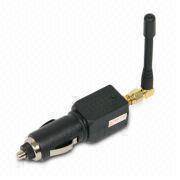
By: Mark Lidikay
I recently ran across this device online and thought it would make a good test. Now to start with jamming radio spectrum is illegal because it makes the frequency unusable to everyone with in some radius. If everyone were deciding what they wanted to allow over the air it would not take long before nothing was usable. In testing this device I started out investigating what it did in a manner that did not allow it to radiate. My initial expectation is that it would do nothing at all since some devices sold online have been found to have nothing but an LED. In this case the device was putting out a signal from 1545MHz to 1645MHz which seems to target the GPS, GLONASS and GALILEO bands. The signal was -40dBm (0.0001mw) directly out of the device, this is not a very strong signal. . This could potentially be a problem for a GPS device that was close enough to the jammer except that there are also GPS and other navigation bands allocated from 1164MHz to 1300MHz.


Since the signal was incredibly feeble, it seemed highly unlikely that it would successfully make its way out of the building, let alone travel any significant distance. Determined to put it to the test, I decided to experiment with its antenna. As I measured the signal three feet away from the device, the reading displayed -95dBm. However, I wanted to give it every chance and decided to take it a step further. Curiosity piqued, I placed my phone and GPS a mere two inches from the device. To my surprise, it continued functioning flawlessly. The GPS effortlessly managed to acquire a precise position despite its close proximity to the device. Intrigued by this remarkable outcome, I couldn’t help but wonder if the GPS had merely stored a previous position. To eliminate any doubts, I embarked on a short trip around a few blocks in my trusty car. Much to my delight, the GPS continued tracking my route with unwavering precision. It was astounding to witness how the feeble signal, which had seemed incapable of achieving anything significant, managed to persevere and provide uninterrupted GPS functionality. It dawned on me that the initial weak signal, compounded by the distance and the presence of my car’s body, would undoubtedly attenuate it to a point where it wouldn’t pose any inconvenience during this short test. Furthermore, this test did not interfere with the GPS system already integrated into my car, making it a seamless and hassle-free experience. As I reflected on the surprising results of this experiment, I couldn’t help but feel a sense of awe at the resilience of technology. The ability of the GPS to overcome the odds and consistently track my position, even in the face of an incredibly weak signal, was a testament to the remarkable advancements in modern navigation systems. It left me contemplating the countless possibilities that lie ahead and the untapped potential of our ever-evolving technological landscape.
The device in question, while it may have possessed some efficacy against the initial GPS units, has unfortunately become obsolete with the allocation of additional bands. Its effectiveness lies in theory, as it could potentially provide a margin of accuracy within a range of approximately 5 or 6 feet. However, in the face of the current GPS units that utilize multiple frequencies to establish connections with satellites, this device has lost its effectiveness entirely. When GPS technology was first introduced, it relied on a single frequency band to communicate with satellites and determine location. At that time, the device in question could have posed a significant threat to the accuracy of these early units. Its ability to interfere with the limited signals of those devices could have potentially disrupted their precision, introducing errors and discrepancies in location tracking. However, as technology progressed and more frequency bands were allocated for GPS use, the landscape changed dramatically. The modern GPS units we rely on today take advantage of these multiple frequencies to establish a stronger and more reliable connection with satellites. By using this advanced system, they are capable of triangulating signals from different satellites and calculating precise positions, even in challenging environments such as urban canyons or dense forests. The multiple frequencies employed by current GPS units have effectively rendered the device in question completely ineffective. Its limited signal interference capabilities pale in comparison to the robust systems utilized by modern navigation devices. These advancements have not only enhanced the accuracy of GPS units but also improved their overall performance and reliability. It is crucial to acknowledge the importance of these technological advancements in our daily lives. GPS technology has transformed the way we navigate and explore the world around us. It has become an indispensable tool for various activities, ranging from guiding us through unfamiliar roads during road trips to assisting emergency responders in locating individuals in distress. The evolution of GPS units, with their ability to lock onto multiple satellite signals, has significantly enhanced the accuracy and reliability of these devices, enabling us to navigate with confidence and peace of mind. In conclusion, while the device in question may have posed a threat to the early GPS units, its effectiveness has been nullified in the face of technological advancements. The allocation of additional frequency bands and the utilization of multiple frequencies by modern GPS units have significantly improved their accuracy and reliability, rendering the device ineffective. We can now rely on these advanced navigation systems to guide us through our journeys, confident in their ability to provide precise and accurate positioning information.